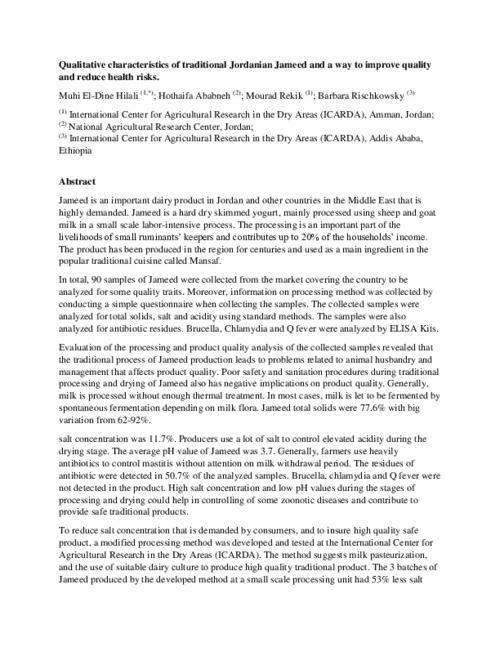Qualitative characteristics of traditional Jordanian Jameed and a way to improve quality and reduce health risks
Abstract
Jameed is an important dairy product in Jordan and other countries in the Middle East that is highly demanded. Jameed is a hard dry skimmed yogurt, mainly processed using sheep and goat milk in a small scale labor-intensive process. The processing is an important part of the livelihoods of small ruminants’ keepers and contributes up to 20% of the households’ income. The product has been produced in the region for centuries and used as a main ingredient in the popular traditional cuisine called Mansaf. 
In total, 90 samples of Jameed were collected from the market covering the country to be analyzed for some quality traits. Moreover, information on processing method was collected by conducting a simple questionnaire when collecting the samples. The collected samples were analyzed for total solids, salt and acidity using standard methods. The samples were also analyzed for antibiotic residues. Brucella, Chlamydia and Q fever were analyzed by ELISA Kits. 
Evaluation of the processing and product quality analysis of the collected samples revealed that the traditional process of Jameed production leads to problems related to animal husbandry and management that affects product quality. Poor safety and sanitation procedures during traditional processing and drying of Jameed also has negative implications on product quality. Generally, milk is processed without enough thermal treatment. In most cases, milk is let to be fermented by spontaneous fermentation depending on milk flora. Jameed total solids were 77.6% with big variation from 62-92%. 
salt concentration was 11.7%. Producers use a lot of salt to control elevated acidity during the drying stage. The average pH value of Jameed was 3.7. Generally, farmers use heavily antibiotics to control mastitis without attention on milk withdrawal period. The residues of antibiotic were detected in 50.7% of the analyzed samples. Brucella, chlamydia and Q fever were not detected in the product. High salt concentration and low pH values during the stages of processing and drying could help in controlling of some zoonotic diseases and contribute to provide safe traditional products. 
To reduce salt concentration that is demanded by consumers, and to insure high quality safe product, a modified processing method was developed and tested at the International Center for Agricultural Research in the Dry Areas (ICARDA). The method suggests milk pasteurization, and the use of suitable dairy culture to produce high quality traditional product. The 3 batches of Jameed produced by the developed method at a small scale processing unit had 53% less salt compared to Jameed from traditional method. Moreover, the product homogeneity was improved by 25% in total solids contents. The use of the modified processing method will provide producers with a method to produce a safe product and capture an additional added value by meeting consumer demands

